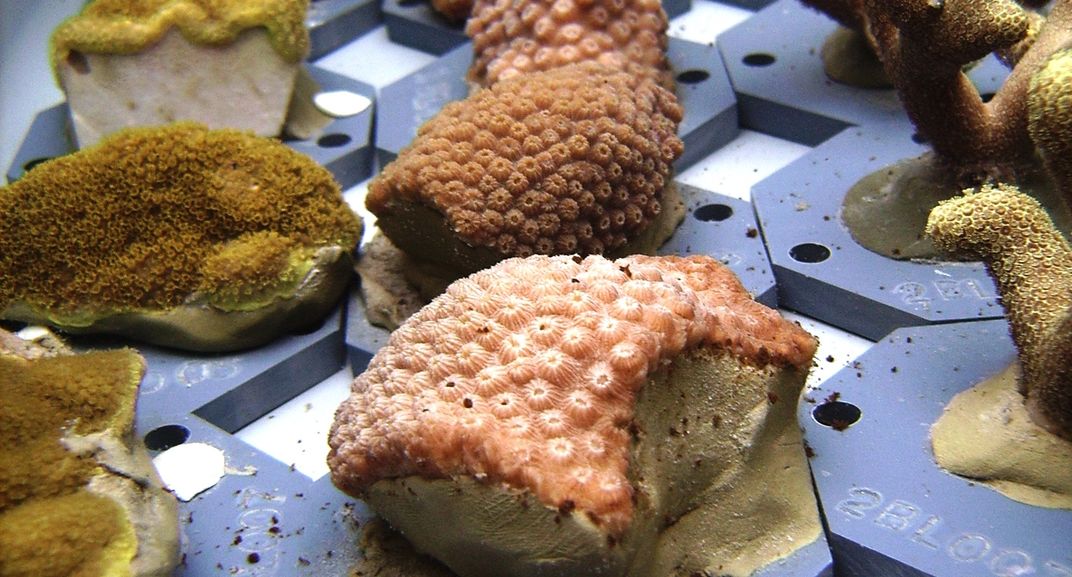Fat Corals Fare Best As Climate Changes
Corals with significant energy reserves that welcome all types of symbiotic algae species won’t easily die if hit with multiple bleaching events
/https://tf-cmsv2-smithsonianmag-media.s3.amazonaws.com/filer/c8/d3/c8d3d858-4765-469f-a1fa-d58ff64d094c/coral.jpg)
Corals don’t live solitary lives. Their existence depends on one-celled algae called zooxanthellae that take up residence inside those ornate structures. The tiny algae give corals oxygen and other nutrients (as well as their beautiful colors), and in return, the corals give the algae carbon dioxide—a symbiotic arrangement.
With global waters warming and increasing in acidity, it’s well known coral reefs are in trouble. Warmer waters cause corals to expel the life-enabling symbiotic algae that they normally pair with, triggering a suicidal process referred to as coral bleaching. Increasing acidity, on the other hand, prevents corals from absorbing the calcium carbonate they need to maintain their skeletons.
Given all these dire findings, it’s no surprise that coral reef research is a hot topic these days (so to speak). Most studies reveal fascinating portents of doom, such as the fact that stressed corals glow brightly before they die, or that sperm and embryonic cell banks might be many coral species’ last hope. A few, however, offer more promising results—such as the fact that one species of coral, at least, seems to be able to tolerate toastier conditions than previously thought.
Now, a new study published in Global Change Biology joins the coral literature, this one offering a mix of good and bad news. The good news is that some corals—specifically, fatty corals that are less discriminating about which algae they pair with—fare better when confronted with warming waters. But the overall message, unfortunately, remains unchanged: Worldwide, global warming will almost certainly cause a decline in coral diversity and reefs.
Researchers from The Ohio State University decided to see what would happen to Caribbean corals that they subjected to warm waters for two years in a row. Other studies have only tested coral bleaching as a single rather than recurring event, reflecting the fact that bleaching normally occurs in nature only rarely. But some studies predict that by 2025, it might be an annual event in the Caribbean.
The researchers collected three types of corals—finger corals, mustard hill corals and boulder corals—from Puerto Morelos Reef National Park in Mexico. They brought the corals back to an outdoor lab, where they increased the water temperature until the delicate organisms bleached. Then, they put the stressed corals back into the ocean to let them recover naturally. To quantify that recovery, they measured things such as the number of algae present in corals cells; the type of algae that came back; and how much fat those cells contained. A year later, they repeated the same process.

The corals were not at all the same in their recovery. The mustard hill coral remained the most fat free of the bunch and only paired with a single algae species. It survived the first year’s trauma, but the second bout of warming proved fatal. The boulder coral fell in the middle; it had healthy fat reserves and partnered up with six different algae species, the proportion of which it mixed and matched after each bleaching event. It survived the second bleaching apocalypse, but its growth was significantly impaired.
The finger coral, however, proved to be a survival champion. It adopted an out-with-the-old approach after both bleaching events, switching to a completely different algal species than it had before. It was also the tubbiest of the three species, with fat reserves 20 to 45 percent greater compared to those of the mustard hill or boulder corals. Additionally, the finger coral seemed nearly unfazed by the bleaching: even after the second event, it simply welcomed in a new species of algae and kept growing as usual.
Although this is good news for the finger coral, researchers worry about what it means for overall coral reef diversity. As waters warm, species such as the finger coral will likely come to dominate the reefs, homogenizing the once vibrant ecosystems. As the researchers write, “The cumulative impact of annual coral bleaching can turn some coral species ‘winners’ into ‘losers.’” With enough bleaching, even the fairly hardy boulder coral, for example, might be forced into decline or even extinction in some reefs.
Those reefs whose coral species aren’t naturally endowed with rich fat reserves and flexible algal needs, on the other hand, will likely quickly die off if hit with bleaching events over consecutive years. These predictions fall in line with other findings in the scientific literature. As one recent study projects, 70 percent of the world’s reefs will have suffered significant damage by 2030.
While the findings aren’t very heartening for coral reefs overall, they do indicate that targeting some coral species—those that are fatter and that more easily make friends with algae—might be an effective conservation strategy, given the higher odds of success.
“If we conserve reefs that contain coral species with these survival traits, then we’re hedging our bets that we might be able to preserve those reefs for an extra decade or two, buying them enough time to acclimatize to climate change,” study author Andréa Grottoli said in a statement.
/https://tf-cmsv2-smithsonianmag-media.s3.amazonaws.com/accounts/headshot/Rachel-Nuwer-240.jpg)
/https://tf-cmsv2-smithsonianmag-media.s3.amazonaws.com/accounts/headshot/Rachel-Nuwer-240.jpg)